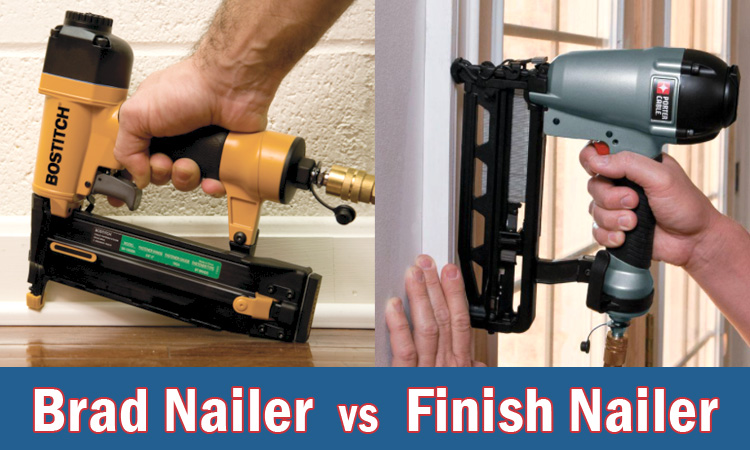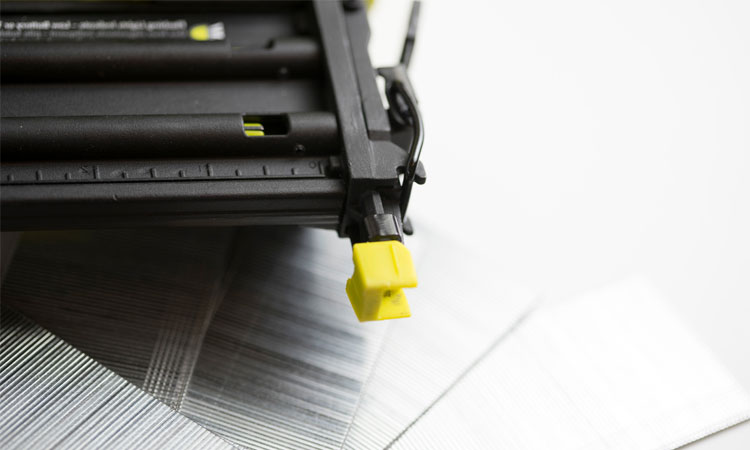Brad Nailer vs Finish Nailer (Uses and Key Differences)

At times, selecting the right tool for a home improvement project can be just as tedious as completing the project itself. Confusion often exists as to which tool provides the most use in a particular situation. This confusion is only exacerbated when two or more tools appear similar in design, yet are distinctive from one another in their uses.
This exact scenario often applies when selecting between the use of a brad nailer and a finish nailer. While it is true that both of these two tools share a somewhat similar design and a number of common characteristics, brad nail guns and finish nail guns are far from universal in their intended uses.
Therefore, it is important to distinguish between each of these two tools, when planning your next home improvement project. Doing so ensures that you are armed with the proper equipment to make the most out of your efforts.
Read on to learn more about the key differences between brad nailers and finish nailers, as well as the intended uses of each.
What is a Brad Nailer?
A brad nailer is a form of nail gun that actually shoots brads, rather than nails. While this seems rather self-explanatory in nature, many often confuse the actual purpose of a brad gun, with that of a nail gun.
The brads used by a brad gun are typically of 18-gauge sizing and are intended to secure trim and molding, rather than to hang heavier structural materials. In fact, the brads applied by a brad nailer will often bend if applied to heavy boards or other bulkier material.
For years, pneumatic brad nailers were the gold standard for trim application. However, in more recent times, battery-powered brad nail guns have begun to grow in popularity. This stems from the fact that battery powered brad nailers are extremely portable, and eliminate the need for an on-site air compressor.
Related: Air Tools vs Cordless Electric Tools
When to Use a Brad Nail Gun
- Hanging trim
- Securing molding
- Setting baseboards of less than 1/2” thickness
- Installing thin paneling
- Constructing picture frames
- Delicate applications where splitting is a concern
What is a Finish Nailer?
A finish nailer is a somewhat larger nail gun, which is intended for use when working with heavier materials. This type of nail gun is most commonly used on job sites, for the purpose of securing thick paneling, where peak holding power is of the essence.
Finish nailers fire 15-16 gauge nails, which feature a more pronounced head than that of brads used in a brad gun. As a result, finish nailers also provide a more secure hold when used on thicker materials, than can be replicated by a brad gun.
Today’s finish nailers come in a number of forms and configurations. Both pneumatic and battery powered models are widely available, with the latter growing significantly in popularity over the past decade.
One can also select between finish nailers with a straight or angled magazine. The final decision between these two variants often comes down to a matter of workspace availability.
When to Use a Finish Nail Gun
- Attaching heavy crown molding
- Constructing window frames
- Assembling cabinetry
- Setting thick baseboards
- Hanging heavy trim
- Any application where tight securement is paramount
Key Differences
The following are several key differences between brad nailers and finish nailers, outlined in a side-by-side comparison. These discrepancies will highlight the value of each tool, when used in specific applications for which they were designed.
Nails
In reality, brad nailers fire small fasteners, called “brads” rather than actual nails. These fasteners are of a relatively small 18-gauge construction and are used to tack lightweight materials in place.
On the contrary, finish nailers fire larger, 15-16 gauge nails, which feature a more pronounced head and are longer in length. These nails, when seated, provide more clamping force than standard brads.
Related: 30 Types of Nails and Their Uses
Hole Size
Due to the smaller gauge of brads than actual nails, brad nailers naturally leave behind smaller holes to contend with. In fact, the average brad measures only 0.0475” in diameter, while finish nails can measure up to 0.0720” in diameter.
However, the trade-off of this is that a brad nailer is incapable of imparting as much clamping force, as a standard finish nailer.
Power
While a brad nailer is ideally suited to fastening thin, lightweight materials in place, it simply lacks the clamping force of the bigger, more powerful finishing nailer. The use of a finish nailer is highly recommended when working with materials that are greater than 1/2” in thickness.
Brads tend to have a much harder time penetrating and securing bulkier payloads, thus leading to project instability.
Versatility
Due solely to its higher rate of power, the finish nailer tends to be more versatile than the brad nailer. However, this is not to say that a brad nailer is unworthy of purchase. A brad nailer is a must when attempting to quickly hang delicate materials that would typically split when applied with a finish nailer.
As a general rule of thumb, the purchase of both a brad nailer and a finish nailer is highly recommended for the avid DIY enthusiast. Each of these tools has its place, and understanding this serves as half the battle.
In many ways, the brad nailer and finish nailer complement one another, and are both worthy of their own rightful spot in any tool cabinet.









